
- Home
- Travel Packages
- Top Destination
-
Travel Attraction
By Category
Top Attraction

- Travel Agents
- Car Rentals
- Hotels
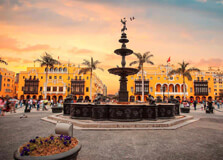
Lima, the capital city of Peru, is a bustling metropolis situated on the country’s Pacific coast. Founded in 1535 by Spanish conquistador Francisco Pizarro, Lima blends rich colonial heritage with modern urban life, making it a dynamic cultural and economic center in South America. As Peru’s largest city and political capital, Lima is home to over 10 million people and serves as the country’s primary hub for commerce, education, and government. The city’s historic center, a UNESCO World Heritage Site, showcases beautiful colonial architecture, including the Plaza Mayor, the impressive Cathedral of Lima, and the Government Palace. Lima also boasts numerous museums, theaters, and galleries that celebrate its diverse history and vibrant arts scene. Known as the “Gastronomic Capital of the Americas,” Lima offers world-renowned cuisine, blending indigenous, Spanish, African, and Asian influences, with celebrated dishes like ceviche and anticuchos. Beyond its cultural wealth, Lima features bustling neighborhoods like Miraflores and Barranco, popular for shopping, nightlife, and coastal views. Despite challenges typical of a large urban area, Lima’s unique mix of history, culture, and modernity continues to attract visitors and businesses alike. The city serves as a gateway to Peru’s famous landmarks, such as Machu Picchu, while standing out as a lively and multifaceted destination in its own right.
Explore More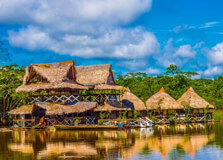
Iquitos is the largest city in the Peruvian Amazon and the world’s largest city inaccessible by road, reachable only by river or air. Situated along the banks of the Amazon River and its tributaries, Iquitos serves as the main gateway to the vast and biodiverse Amazon rainforest. Known as the "Capital of the Peruvian Amazon," the city is a vital cultural, economic, and transportation hub for the surrounding jungle communities. Founded in the 18th century, Iquitos grew rapidly during the rubber boom in the late 19th and early 20th centuries, leaving behind beautiful colonial architecture and historic mansions that still line parts of the city. The local culture is a unique blend of indigenous traditions and modern urban life, with vibrant markets, bustling river ports, and a lively arts scene. Iquitos is famous for its ecotourism, offering access to nearby protected areas like the Pacaya-Samiria National Reserve and numerous jungle lodges where visitors can experience wildlife, river cruises, and indigenous culture firsthand. The city’s tropical climate, rich biodiversity, and remote location make it an ideal base for exploring the Amazon’s unparalleled natural wonders. Iquitos offers an immersive experience into one of the world’s most vital ecosystems, balancing urban charm with wild adventure.
Explore More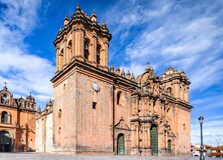
Cusco, nestled high in the Peruvian Andes at about 3,400 meters (11,200 feet) above sea level, is one of South America’s most historically and culturally significant cities. Once the capital of the Inca Empire, Cusco is a UNESCO World Heritage Site and serves as a vibrant gateway to the world-famous Machu Picchu and the Sacred Valley. Its rich history, stunning architecture, and blend of indigenous and colonial influences make it a top destination for travelers worldwide. The city’s streets are lined with well-preserved Incan ruins and Spanish colonial buildings, exemplified by landmarks such as the impressive **Sacsayhuamán fortress**, the **Qorikancha (Temple of the Sun)**, and the beautiful **Plaza de Armas** surrounded by churches and lively markets. Cusco is also known for its vibrant festivals, colorful traditional textiles, and rich Andean cuisine. Modern Cusco balances its historic charm with a lively urban vibe, offering boutique hotels, cafes, artisan shops, and a thriving nightlife. Despite its popularity with tourists, the city retains a strong connection to its Quechua heritage, with many locals preserving ancient customs and languages. Cusco is not only a cultural treasure but also a spiritual and archaeological hub, offering visitors an immersive experience into Peru’s indigenous past and breathtaking natural landscapes.
Explore More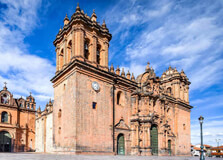
Cuzco, also spelled Cusco, is a historic city located in southeastern Peru, nestled high in the Andes Mountains at an elevation of approximately 3,400 meters (11,200 feet). Once the vibrant capital of the Inca Empire, Cuzco remains a cultural and archaeological treasure, celebrated for its remarkable blend of indigenous Incan and Spanish colonial heritage. It is widely recognized as the gateway to Machu Picchu, one of the New Seven Wonders of the World. The city’s rich history is reflected in its stunning architecture, where ancient Incan stonework coexists seamlessly with colonial churches and plazas. Notable sites include the impressive Sacsayhuamán fortress, the Qorikancha (Temple of the Sun), and the Plaza de Armas, which serves as the heart of the city. Cuzco’s narrow cobblestone streets are lined with vibrant markets, artisan shops, and traditional eateries offering local Andean cuisine. Cuzco is also a cultural hub, hosting numerous festivals throughout the year that showcase indigenous music, dance, and religious traditions. Despite its status as a popular tourist destination, the city retains its authentic spirit, with many residents preserving Quechua language and customs. Offering a unique mix of history, culture, and breathtaking mountain scenery, Cuzco provides visitors with an unforgettable experience deeply connected to Peru’s ancient past and living traditions.
Explore More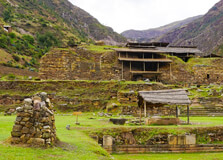
Huaraz is a picturesque city located in the northern Peruvian Andes, serving as the gateway to the stunning Cordillera Blanca mountain range. Situated at an altitude of about 3,050 meters (10,000 feet), Huaraz is renowned for its breathtaking natural beauty, attracting hikers, climbers, and adventure enthusiasts from around the world. The city is a base for exploring some of Peru’s most spectacular high-altitude landscapes, including snow-capped peaks, turquoise glacial lakes, and deep valleys. Huaraz is famous for its proximity to the Huascarán National Park, a UNESCO World Heritage Site that protects the highest tropical mountain range on Earth. This park includes Peru’s tallest peak, Huascarán, which rises over 6,700 meters (22,000 feet). Visitors can explore famous trekking routes such as the Santa Cruz trek, which offers panoramic views of glaciers and Andean flora. The city itself blends modern conveniences with traditional Andean culture, boasting lively markets, artisan shops, and local cuisine that highlights native ingredients like potatoes, quinoa, and trout. Huaraz also has a rich archaeological heritage, including nearby pre-Incan ruins such as Chavín de Huántar. With its combination of outdoor adventure, cultural richness, and stunning mountain scenery, Huaraz is a must-visit destination for travelers seeking authentic Andean experiences.
Explore More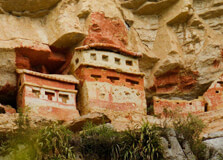
Chachapoyas is a charming city located in the northern highlands of Peru, serving as the capital of the Amazonas region. Nestled at about 2,335 meters (7,660 feet) above sea level, the city offers a pleasant climate and stunning natural scenery, characterized by lush cloud forests, deep canyons, and cascading waterfalls. Chachapoyas is an important cultural and historical center, known as the gateway to the ancient Chachapoya civilization, often called the “Warriors of the Clouds.” The region is famous for its remarkable archaeological sites, the most iconic being **Kuelap**, a massive stone fortress perched atop a mountain ridge. This pre-Incan site, often compared to Machu Picchu, is one of the largest and most impressive ruins in South America. Nearby attractions include the **Gocta Waterfall**, one of the tallest waterfalls in the world, and the mysterious sarcophagi of **Karajia**. Chachapoyas blends traditional Andean culture with a tranquil small-town atmosphere. Visitors can explore local markets, sample regional cuisine, and interact with warm, welcoming communities. Its combination of rich history, spectacular landscapes, and authentic cultural experiences makes Chachapoyas a fascinating destination for travelers seeking to explore Peru beyond the usual tourist routes.
Explore MoreMystic Peaks - Lost Cities - The Inca Trail To Machu Picchu 7N 8D Tour
8 Days/ 7 Night
Cusco
South America Explorer 14 Nights - 15 Days Tour
15 Days/ 14 Night
Rio De Janeiro - Lima - Buenos Aires - Cusco - Iguassu Falls
Peru & Galapagos Cruise Tour
16 Days/ 15 Night
Lima
Complete Tour of Southern Peru with Manu NP
24 Days/ 23 Night
Cusco - Colima - Arequipa - Arica - Kishtwar - Pilbara - Caldera - Nachikatsuura - Eluru - Flatts Village - Santa Ana - Qasigiannguit
The country of Peru has much to offer to tourists. Ranging from high mountain ranges to the beautiful beaches, from vast deserts to the dense tropical forests, Peru has a lot to offer. In addition, the rich archaeological & historical past makes Peru a center of attraction.
Peru offers diverse attractions like archaeology, beaches, mountains, sports, medicinal springs, fantastic landscapes, nature, and mesmeric music. You would really enjoy watching the locals, who wear quite colorful clothes. The women wear multi-colored petticoats & bowler hats, while men are dressed in colorful, floppy, wooly hats.
1,285,216 square km (496,225 square miles)
30,475,144 (estimated)
Spanish
+51
PET (UTC?5)
Some of the chief tourist destinations and attractions of Peru are listed below : -
√ Machu Picchu (the best archaeological site). √ Inca Trail. √ Aguas Calientes. √ Cuzco. √ Lake Titicaca. √ Altiplano. √ Taquile Island. √ Nazca Desert. √ Amazon. √ Ollaytaytambo. √ Sacsayhuamn. √ Manu National Park √ Blanquillo Ecological Reserve. √ Tambopata-Candamo Reserved Zone. √ Uros (the floating village). √ Church of San Francisco. √ Punta Sal Beach. √ The Sacred Valley. √ Punta Veleros Beach, etc.
Peru.
Lima.
Nuevo Sol (PEN).
Machu Picchu.
Peru has a diverse climate which depends on the place. The coastal areas witness moderate temperatures, the Peruvian highlands witness frequent rains, and the forest areas have heavy rainfall.
The geography of Peru is divided into the three regions of costa or the coast, sierra or the highlands, and the selva or the forests. The Amazon Rainforest and the Amazon River are well-known to the tourists who flock in from all over the world.
Territory & Capital : Peru is situated in western part of South America and is bordered by Colombia & Ecuador on north and by Brazil on the east. On the southern side lies Chile, while on the west lies the Pacific Ocean. Lima is the capital and the largest city of Peru.
Suitable Visiting Seasons : The period from June to August is the time when there is maximum inflow of tourist. This is the dry season when the temperatures are also on the lower side.
Railways, metros, and long-distance buses are the prominent ways of transportation in Peru. The roadways provide excellent means for inner-country travel. Airways and waterways are also prominent means of transport.
Contact the nearest Peruvian embassy for details on the procedures of obtaining the Peruvian visa.